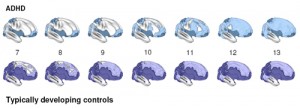Children with ADHD: Attention Deficit (Hyperactive) Disorder
By age one year, typically developing toddlers listen to rhymes and songs. By age two, they love short stories, and by three years of age, they start following simple instructions. By age four children engage in play with others, complete short activities, like building with blocks, drawing, or modeling with play-dough for at least 5-10 minutes.
Some children find it challenging to focus on one task. They may also appear to have so much energy that engaging in one activity is almost impossible. There is a difference between children who are very curious and/or active and children who will only engage in these activities with one on one support.
This difference is important to note, because it can help parents and service providers observe a child and seek professional information about attention-deficit/hyperactivity disorder (ADHD). This is a condition that impacts approximately 5%1 or 1 in every 20 children (between ages 3 and 9 years) in North America . It is often connected to learning disabilities, behavioral difficulties and giftedness.
Description
Attention-deficit/hyperactivity disorder (ADHD) is a common neurobehavioral (see full Glossary) disorder. It relates to the brain’s chemistry and anatomy (Fig. 1).
Figure 1. Brain Difference
The symptoms of ADHD fall into the following categories: inattention, hyperactivity/impulsivity, and a combination of the two.
The definition of ADHD includes the following: 1) Difficulties with attention persist –they not just appear and disappear; 2) High levels of activity are present, to the point that the child does not seem to have control on their own; 3) A tendency to be impulsive, or to react without thinking, that does not seem to change as the child grows 4) These symptoms have to be observed for at least six months; most of them show up by the time the child turns 7 years old.
ADHD begins in childhood and symptoms can continue into adulthood. While some children outgrow ADHD, as many as 60% continue to have features of ADHD as adults.
Intervention Options
- Infant Development and Supported Child Development consultants can be involved with young preschool and school-age children who have difficulties sustaining attention and who show signs of hyperactivity.
- Intervention options include strategies that can be followed at home and at preschool/school with parents and teachers and other service providers;
- To help with inattention, daily routines set with visual reminders support the child to be independent on one or more of the following:
- What to bring to –from school (snack, clothing, materials);
- Time and daily schedules.
- Support to invite the child to self-regulate hyperactive and impulsive behavior includes the use of social stories and reward system for completion of activities without interrupting, and for any example of pro-social behaviours, among others.
- Self-regulation is key for success in all children; children with ADHD benefit the most when they are provided with effective strategies to work on self-regulation skills, supported by their parents and teachers/other service providers.
- A pediatrician is usually involved with young children diagnosed with attention deficit hyperactive disorder and, in consultation with a child psychiatrist they may prescribe medication
To learn about ADHD in the middle childhood years, please visit the six to 12 section of this course.

0 comments
Kick things off by filling out the form below.
You must log in to post a comment.